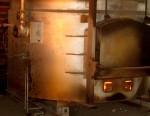As a golf club manufacturer I have had the privilege of visiting many of the top club making facilities in China.
The manufacturing method of a golf club depends on the type of club being manufactured. Irons, fairway woods, wedges, hybrids and putters are generally cast while drivers and high end iron sets are manufactured using a forging process.
It is more than likely that most of the golf clubs in your bag were manufactured using a casting process similar to that described below.
Before a golf club is put into production, it is designed on a computer using sophisticated CAD software. The computer design is used as the basis for the development of a proprietary mold. Once a mold has been produced it is used in the production of each and every club head.
As you can see in (Figure 1), the mold is a mirror image of the club head. The mold has two parts to it and has a small opening on the side. The mold is inserted into a wax injection molding machine (Figure 2) and boiling hot wax is squirted into the mold. The outcome is a golf club head that is made of wax. A wax mold is made for every piece that is manufactured. For example a set of 9 irons will require 9 wax molds, each representing a different loft.
The wax molds are then checked individually for minor blemishes (Figure 3) and a fine nail file is used to remove excess wax particles that might be present on the mold. This is important as any imperfections on the wax mold will be present in the production club head. Again, this takes place manually, and each club head piece is subject to this process.
The wax club heads are then melted onto a wax tree in groups of 14 (Figure 4) and dipped into quicksand (Figure 5). The quicksand adheres to the wax and forms a shell around the outskirts of the mold. The tree is left to dry in a refrigerated room and this process is repeated five times.
Quicksand is used because it can withstand the extreme temperatures required when pouring the molten iron and also because of its ability to form a perfectly smooth shell around the intricate details of the wax club head.
Once the fifth round of quicksand has dried, the tree is inserted into a steam oven. The steam heats up the wax and it melts out from the inside of the quicksand tree. The top of the quicksand tree is shaped liked a funnel making it easy to pour the molten iron into the quicksand shell.
The quicksand molds are transported to a furnace as shown in (Figure 6). A stainless steel alloy is heated up to 1500° celsius at which point it becomes molten liquid and glows red hot. Once the metal is molten and the quick sand is the same temperature, the quicksand molds are removed from the furnace and walked across to the pouring station where the molten steel is poured into the quicksand mold (Figure 7).
The red hot quicksand molds containing the molten metal are placed on a shelf of sand and left to harden as in ( Figure 8 ) . Once the steel has hardened, the quicksand outer shell is cracked off the iron molds and the unpolished golf heads are exposed. At this stage the club heads are still connected to the tree.
The club heads are individually cut off of the tree by a metal cutter and the finishing process begins from a head looking like the one in (Figure 9).
The finishing process is a long process. It begins by polishing the club head and sandblasting the face.
Once the club has been polished and sand blasted, it goes through a quality assurance process where the loft, lie, weight, hozel diameter and variance measurements are tested to ensure they fall within the strict tolerances set by the manufacturer of the clubs and by the R&A.
The club heads are then trucked to a different location where skilled workers paint the logos and score lines onto the club head. The logo’s are a part of the original mold however they must be colored in before they are ready to be sold and used.
by Brad Lindenberg
Get Stories Like
These Everyday!

























Andrew Dustin
11 months ago
I read your both articles on this topic – Casting and Forging. Quite informative and easy to understand. Thanks for sharing it.